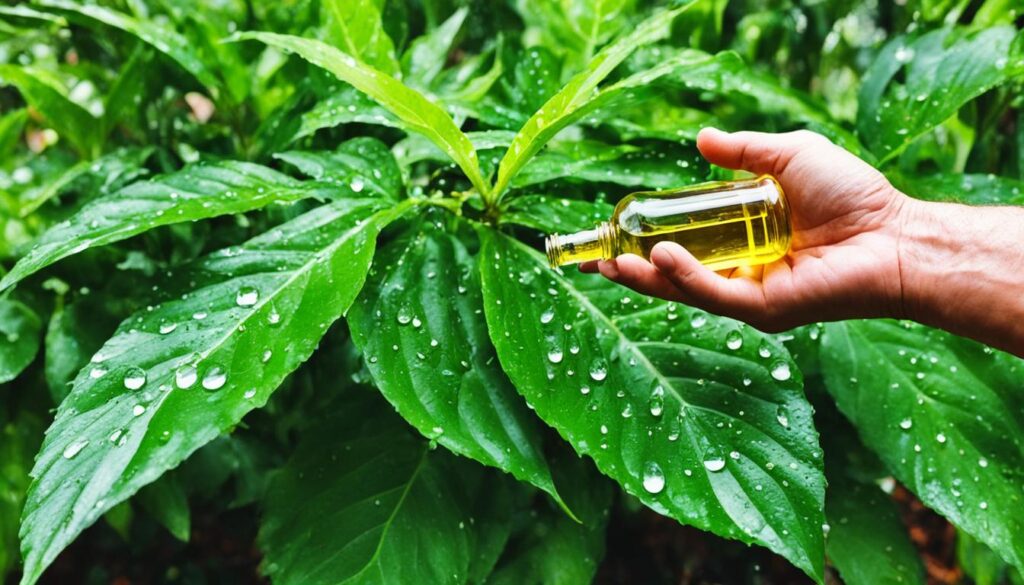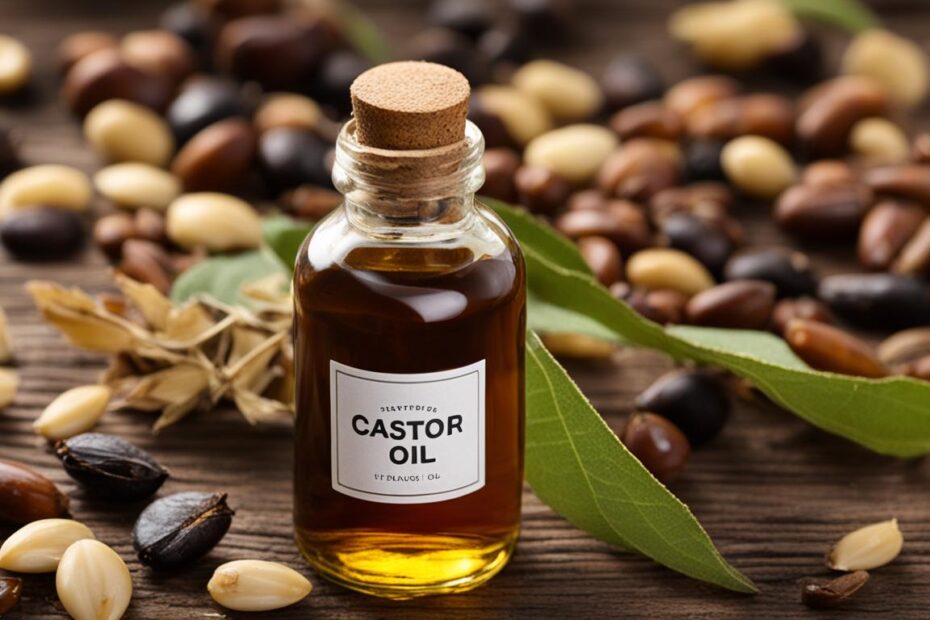When it comes to skincare, finding the right products for your routine is crucial. One ingredient that has gained popularity in recent years is castor oil. But is castor oil a carrier oil? Let’s take a closer look.
Castor oil has long been used for its healing properties and is often found in skincare products. Its thick texture and moisturizing abilities make it an ideal candidate for diluting essential oils and promoting healthy skin. But is it considered a carrier oil?
Key Takeaways:
- Castor oil is commonly used in skincare products for its healing properties.
- Its moisturizing and anti-inflammatory properties make it an ideal carrier oil.
- Castor oil can be used to dilute essential oils and promote healthy skin.
- When choosing castor oil, opt for high-quality, pure varieties.
- Perform a patch test if you have sensitive skin.
The History of Castor Oil
Castor oil, also known as “Palma Christi” or “Hand of Christ,” has a long and fascinating history. Its usage as a remedy can be traced back centuries, with evidence of its medicinal properties found in ancient civilizations.
One of the earliest references to castor oil can be found in the Ebers Papyrus, an Egyptian medical document dating back to 1550 BCE. It highlights the use of castor oil as a treatment for various ailments, including constipation and eye irritations.
In ancient Rome, castor oil gained popularity as a laxative and was commonly used in medical practices. The Roman philosopher Pliny the Elder mentioned castor oil in his natural history texts, praising its effectiveness in treating diseases such as epilepsy and rheumatism.
“Castor oil is Nature’s gift to humanity. Its healing properties have been revered by different cultures throughout history.”
In traditional Indian medicine, castor oil has been highly regarded for its therapeutic benefits. The ancient Indian medical system of Ayurveda views castor oil as a powerful remedy for expelling toxins from the body and promoting overall health.
During the Middle Ages, castor oil continued to be used for its medicinal properties. It was believed to possess mystical qualities and was associated with various religious beliefs. The name “Palma Christi” came about due to the belief that castor leaves resembled the shape of Christ’s palm.
The American psychic healer Edgar Casey, often referred to as the Father of Holistic Medicine, played a significant role in popularizing the healing properties of castor oil in the early 20th century. Casey recommended the use of castor oil packs for various health issues, including digestive disorders and skin conditions.
“The healing properties of castor oil have been recognized by visionary figures throughout history, such as Edgar Casey.”
Today, castor oil continues to be celebrated for its versatility and therapeutic benefits. Its rich history and enduring reputation as a healing remedy make it a popular choice in skincare, haircare, and natural medicine.
| Time Period | Significance |
|---|---|
| 1550 BCE | Evidence of castor oil usage found in the Ebers Papyrus |
| Ancient Rome | Widespread use of castor oil as a laxative and medical treatment |
| Ancient India | Castor oil valued in Ayurvedic medicine for detoxification |
| Middle Ages | Castor oil associated with religious beliefs, known as “Palma Christi” |
| 20th Century | Edgar Casey popularized the therapeutic use of castor oil |
The Benefits of Castor Oil
Castor oil is a versatile and powerful skincare ingredient with numerous benefits for the skin. It contains a high concentration of ricinoleic acid, which gives it its exceptional properties. Let’s take a closer look at the various benefits castor oil provides:
1. Anti-inflammatory Properties
One of the key advantages of castor oil is its anti-inflammatory properties. Ricinoleic acid, the main component of castor oil, has been found to reduce inflammation and soothe irritated skin. It can be especially beneficial for individuals with skin conditions like eczema or psoriasis.
2. Antibacterial Activity
Castor oil also exhibits antibacterial activity, making it effective against acne-causing bacteria. The oil can penetrate the skin and help eliminate bacteria, reducing the occurrence of breakouts and promoting a clearer complexion.
3. Moisturizing and Softening
In addition to its anti-inflammatory and antibacterial properties, castor oil is an excellent moisturizer. It helps hydrate the skin, keeping it soft and supple. Regular use of castor oil can improve skin texture and prevent dryness.
4. Hair Growth Stimulant
Castor oil is not only beneficial for the skin but also for promoting hair growth. Its ricinoleic acid content stimulates blood circulation in the scalp, facilitating the delivery of essential nutrients to the hair follicles. This can help strengthen the hair and encourage healthy growth.
5. Wrinkle Reduction
Due to its moisturizing properties, castor oil can also reduce the appearance of wrinkles and fine lines. Regular application of castor oil can soften the skin, improve elasticity, and minimize the signs of aging.
6. Wound Healing
Castor oil has been traditionally used for wound healing purposes. Its anti-inflammatory and antibacterial properties help protect wounds from infection and promote faster healing. The oil can also help reduce the appearance of scars and stretch marks.
To summarize, castor oil offers a wide range of skin benefits, including anti-inflammatory, antibacterial, moisturizing, hair growth-stimulating, wrinkle-reducing, and wound-healing properties. Its ricinoleic acid content makes it a valuable addition to any skincare routine.

| Benefits of Castor Oil |
|---|
| Anti-inflammatory effects |
| Antibacterial activity |
| Moisturizing and softening properties |
| Promotes hair growth |
| Reduces wrinkles |
| Facilitates wound healing |
Cultivating Quality Castor Oil
To obtain high-quality castor oil, it is crucial to ensure proper cultivation practices. Cultivating castor oil involves considerations of soil conditions, as well as a meticulous harvesting process.
Soil Conditions
Castor plants exhibit remarkable adaptability and can thrive in various soil types. However, for optimal growth and oil production, specific soil conditions are preferable. The ideal soil for cultivating castor oil is well-drained, deep, and moderately fertile. Adequate water drainage is essential to prevent waterlogging, which can adversely affect plant health and oil quality. Additionally, a deep and fertile soil profile facilitates the development of a robust root system, enabling the plants to absorb necessary nutrients and water efficiently.
Harvesting Process
The harvesting process plays a vital role in obtaining high-quality castor oil. Castor beans, also known as capsules, are typically sown during the rainy season when the soil moisture is optimal for germination. The beans then go through a meticulous process of maturation. Once mature, the harvesting takes place by carefully stripping off the capsules from the plants. This step is often done by hand in tropical regions, ensuring minimal damage to the beans and preserving their quality.
The hand harvesting method, although labor-intensive, offers precise control over the quality and integrity of the harvested beans. By meticulously following the harvesting process, producers can obtain castor beans with high oil content, ensuring the subsequent extraction yields premium-grade castor oil.
| Soil Conditions for Cultivating Quality Castor Oil | Harvesting Process for Obtaining High-Quality Castor Beans |
|---|---|
| Well-drained, deep, and moderately fertile soil | Meticulous hand-stripping of mature capsules |
| Adequate water drainage | Precise control for minimal bean damage |
| Optimal moisture levels for germination | Preservation of bean quality during harvesting |
Extracting Castor Oil
Castor oil is extracted through a meticulous process that involves cold-pressing castor seeds and applying heat. This combination of techniques ensures the efficient extraction of the oil while preserving its natural properties.
Cold-pressing is the initial step in the extraction process. It involves pressing castor seeds without the use of excessive heat, which helps retain the oil’s beneficial compounds, including its moisturizing, anti-inflammatory, and antibacterial properties. This method ensures that the resulting oil is of high quality and suitable for use in various skincare and haircare products.
Once the castor seeds have undergone cold-pressing, heat is applied to separate the oil from the solid residue. This heat application helps to further enhance the extraction process, ensuring that the maximum amount of oil is obtained.
The extracted castor oil retains its unique properties, making it an ideal ingredient for skincare products due to its moisturizing effects, its ability to reduce inflammation, and its natural antibacterial properties. Additionally, it can be used in haircare products to promote hair growth and maintain scalp health.

| Extraction Process | Advantages |
|---|---|
| Cold-pressing castor seeds |
|
| Heat application |
|
Uses of Castor Oil
Castor oil is a versatile oil that finds extensive use in skincare, haircare, and medicinal applications. Its moisturizing properties make it a popular ingredient in cosmetic products such as soaps, moisturizers, and massage oils. The oil’s ability to penetrate deep into the skin helps repair damaged hair follicles, leading to healthier and stronger hair.
When it comes to skincare, castor oil is a powerful ally. Its emollient properties help soften the skin, making it an excellent natural moisturizer. Additionally, the oil’s anti-inflammatory and antibacterial properties make it effective in reducing acne breakouts and soothing skin irritations. People with conditions like eczema and psoriasis also use castor oil to alleviate symptoms and promote healing.
Aside from its skincare benefits, castor oil is known for its medicinal applications. It is commonly used to reduce muscle pain and inflammation due to its analgesic properties. The oil’s anti-inflammatory effects help ease joint pain and promote faster recovery from injuries.
Below is a table highlighting the numerous uses of castor oil:
| Skincare | Haircare | Medicinal Applications |
|---|---|---|
| Moisturizes and softens the skin | Repairs damaged hair | Reduces muscle pain and inflammation |
| Reduces acne breakouts | Promotes hair growth | Eases joint pain |
| Soothes skin irritations | Nourishes the scalp | Accelerates wound healing |
| Treats eczema and psoriasis | Moisturizes dry and brittle hair | Relieves arthritis pain |
With its wide range of uses, castor oil has become a staple in many households. However, it’s important to note that individual results may vary, and it’s always advisable to consult with a healthcare professional before incorporating castor oil into your skincare or haircare routine.

Stay tuned for the next section where we’ll explore the different varieties of castor oil and their unique qualities.
Castor Oil Varieties
When it comes to castor oil, there are several varieties available, each with its own unique properties. Understanding the differences between these varieties can help you choose the best type of castor oil for your specific needs.
Unrefined Castor Oil
Unrefined castor oil is the purest form of castor oil available. It is extracted from the castor seeds without any chemical processes or refinement. This variety retains the highest concentration of beneficial compounds, including essential fatty acids, vitamins, and minerals. It is free from additives and is considered the most natural and potent form of castor oil.
Virgin Castor Oil
Virgin castor oil is also derived from the first pressing of castor seeds, similar to unrefined castor oil. However, it may undergo minimal refinement processes to remove impurities. While it is not as pure as unrefined castor oil, it still retains a significant amount of beneficial compounds and can be a good option for those looking for a slightly refined version.
Cold-Pressed Castor Oil
Cold-pressed castor oil is obtained by pressing the castor seeds without the use of heat. This extraction method helps preserve the oil’s natural properties, including its moisturizing, anti-inflammatory, and antibacterial benefits. Cold-pressed castor oil is often preferred for skincare and haircare products as it retains more of the oil’s original nutrients and beneficial compounds.
Contraindications for Castor Oil
While castor oil is generally safe for topical use, it is important to be aware of possible contraindications. Some individuals may experience sensitivity or allergies to castor oil, resulting in skin irritation, redness, or itching. To determine if you have any adverse reactions, it is recommended to perform a patch test before using castor oil on a larger area of the skin.
During a patch test, apply a small amount of castor oil to a small patch of skin, such as the inner forearm or behind the ear. Leave it on for 24 to 48 hours and observe for any negative reactions. If you experience any discomfort, swelling, or severe redness, discontinue use and consult a healthcare professional.
Additionally, pregnant women should exercise caution when using castor oil orally. Castor oil has been used historically to induce labor due to its stimulant effect on the bowels. However, its safety and effectiveness for labor induction are not well-established, and it should only be used under the guidance of a healthcare professional.
It is essential to prioritize your safety and well-being when using castor oil. If you have any concerns or preexisting conditions, it is advisable to consult a healthcare professional before incorporating castor oil into your skincare or haircare routine.
Conclusion
After exploring the benefits and uses of castor oil, it is clear that this natural wonder is indeed a versatile carrier oil. Its moisturizing, anti-inflammatory, and antibacterial properties make it a valuable ingredient in skincare and haircare products. With its ability to dilute essential oils, castor oil enhances their effects and promotes a healthier, more radiant complexion.
When incorporating castor oil into your skincare routine, it is crucial to select high-quality, pure varieties to ensure maximum efficacy. Additionally, it’s important to perform a patch test before applying castor oil to larger areas of your skin, especially if you have sensitive skin or known allergies.
Whether you’re looking to moisturize dry skin, soothe irritation, or promote hair growth, castor oil is a reliable and natural solution. Its long history of use and its numerous benefits make it a go-to choice for those seeking healthier, more nourished skin and hair.
FAQ
Is castor oil a carrier oil?
Yes, castor oil is a carrier oil commonly used in skincare routines. It has a thick texture and is known for its moisturizing and anti-inflammatory properties, making it an ideal carrier oil for diluting essential oils and promoting healthy skin.
What is the history of castor oil?
Castor oil, also known as “Palma Christi” or “Hand of Christ,” has a long history of use as a remedy. It was traditionally used for birth control, as well as for treating leprosy and syphilis. Edgar Casey, considered the Father of Holistic Medicine, popularized the healing properties of castor oil for various health issues.
What are the benefits of castor oil?
Castor oil is rich in ricinoleic acid, which has numerous benefits for the skin. It has anti-inflammatory properties, helps soothe irritation, fights acne-causing bacteria, boosts circulation, and promotes hair growth. It also moisturizes and softens the skin, reduces wrinkles, and facilitates wound healing.
How is castor oil cultivated?
Castor plants can grow in various soil types, as long as they have adequate water drainage. The ideal soil is well-drained, deep, and moderately fertile. Castor beans are typically sown during the rainy season and harvested by stripping off the capsules. The beans are harvested by hand in tropical areas.
How is castor oil extracted?
Castor oil is extracted by cold-pressing castor seeds and applying heat. Cold-pressing helps retain the oil’s natural properties, while heat application ensures better extraction. This method allows the oil to retain its moisturizing, anti-inflammatory, and antibacterial properties, making it suitable for skincare and haircare products.
What are the uses of castor oil?
Castor oil is widely used for skincare, haircare, and medicinal purposes. It is used in cosmetic products such as soaps, moisturizers, and massage oils due to its moisturizing properties. It is also used to repair hair, soften skin, reduce muscle pain, and treat skin conditions like acne, eczema, and psoriasis.
What are the varieties of castor oil?
Castor oil comes in various varieties, including unrefined, virgin, and cold-pressed. Unrefined castor oil is the best choice as it retains the highest concentration of beneficial compounds and is free from chemical processes. Cold-pressed castor oil is obtained by pressing the seeds without the use of heat, preserving its natural properties.
Are there any contraindications for using castor oil?
While castor oil is generally safe for topical use, some individuals may experience sensitivity or allergies to the oil. It is recommended to perform a patch test before using castor oil on a larger area of the skin. Pregnant women should avoid using castor oil orally as it can induce labor.
Can castor oil be used as a carrier oil?
Yes, castor oil is indeed a carrier oil and is commonly used in skincare and haircare products. It has numerous benefits for the skin, including moisturizing, anti-inflammatory, and antibacterial properties. It can be easily mixed with essential oils to dilute their potency and enhance their effects. When using castor oil, it is important to choose high-quality, pure varieties and perform a patch test if you have sensitive skin.




